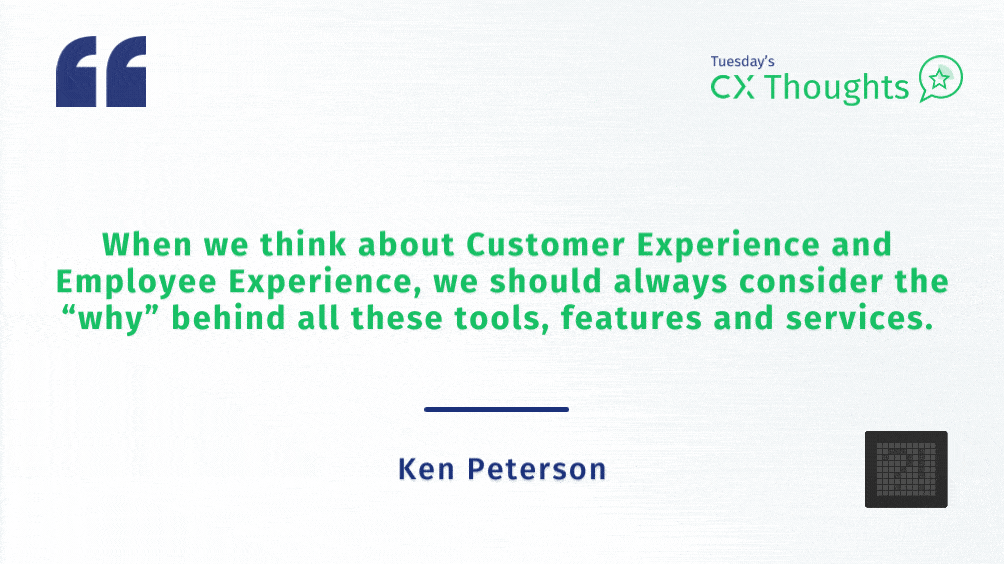
When talking about customer experience with some practitioners, we tend to get caught up in discussions about customer journey, financial linkage analysis, customer experience strategy and customer experience touchpoints. If you are speaking with a customer experience software platform provider, you’ll likely start hearing more industry jargon like customer feedback loop, sentiment analysis, or social media analysis. Even myself, when talking to new acquaintances about “what I do for a living” I tend to fall back on the things we bring to the market: Voice-of-the-Customer surveys and CX Enterprise Software.
However, when we think about Customer Experience and even Employee Experience, we should always keep in mind the “why” behind all these tools, features, and services. Just like I wrote recently in “What’s Your Ideal Voice of the Customer Approach?” for CMS Wire, surveys are only the beginning. Here are five words that you should be thinking about when you think about Customer Experience:
- Emotions – as someone that has a strong focus on operations related to customer experience, I know how easy it is to forget the emotional element of customer experience. Consider that when all else is equal, it will be the customers’ emotional relationships with the brands that will determine which brand is selected. If you’ve ever read the Wallet Allocation Rule, the core premise revolves around the share-of-wallet and the decision process.
- Empathy – this is what customer experience measurement is all about. Trying to understand things from the customers’ perspectives. Whether it is B2C or B2B focused, your survey should be that connection between what happened to the customer and how they feel about those experiences. Not an easy assignment, think about how difficult that is with someone you know well. Now try to understand and share the feelings of thousands of customers that you don’t know on a personal level. However, just because it isn’t easy, doesn’t mean we shouldn’t pursue that. Customer empathy should be considered in every customer journey map, customer experience survey and reporting dashboard. If you want to learn more about empathy at scale, listen to this podcast from Anthrolytics.
- Delight – this is often completely misinterpreted in my view. Delight doesn’t simply come from a Promoter or Top Box score, it has to be earned during every transaction. Keep in mind that something that delights you in this transaction, will be a standard for the next transaction – so it has to be sustainable. I wrote about that before here, and will write about it again no doubt.
- Experience – the “really?” moment of this list. I can hear it now: “Experience is in the phrase Customer Experience”. Absolutely, but too often I see companies forget that it is about improving experience and instead begin to focus on the scores, closed-loop resolution and linkage analysis. All very important, however if you are not gathering this data to improve the customers’ experience, then you’ve lost focus or never had good intentions when you launched your program. It is a core reason we have Outer Loop as part of our QuestionPro CX platform. Experience improvement plans start with strategy at the top that is executed by the front line. If all you do is respond to complaints, you are improving the experience on an ad-hoc basis and not really improving the overall experience with a focus on Delight (see above).
- Customer – the next “really?” I already hear you thinking. However, I have been in so many meetings about Customer Experience where the customer is rarely mentioned. There are so many customer stories that should be discussed, instead there is a focus on the direction of KPIs, drivers analyses, sentiment analysis and response rates. All too often, when the news is bad it is easy to blame all these things – and sometimes even blame the customer (yes, I’ve heard “They don’t know how good they have it with us” coming from an executive when referencing their customers). In any organization, I urge management teams to take some time from two perspectives, that of the frontline employees and that of the customers based on the personas developed. It is not the same to be a customer knowing that – if something goes wrong – you can pull your “I work here” card and get something fixed. Go home with that purchase and be forced to understand the post-transaction process a customer encounters. Call the contact center from an unknown phone to understand the experience. As a loyal high-status customer to an airline, I already know that I experience my transaction differently than most customers, I get connected immediately. Employees also know how to bypass the protocols, but that disconnects them from the reality of their customers.
You probably already feel like these five words are a part of your Customer Experience program, but take some time to put each of these in you next huddle agenda and see if you are really taking them seriously.
Looking to deliver an exceptional customer experience? Discover more about how to delight your customer at every touchpoint and turn them into brand advocates.







